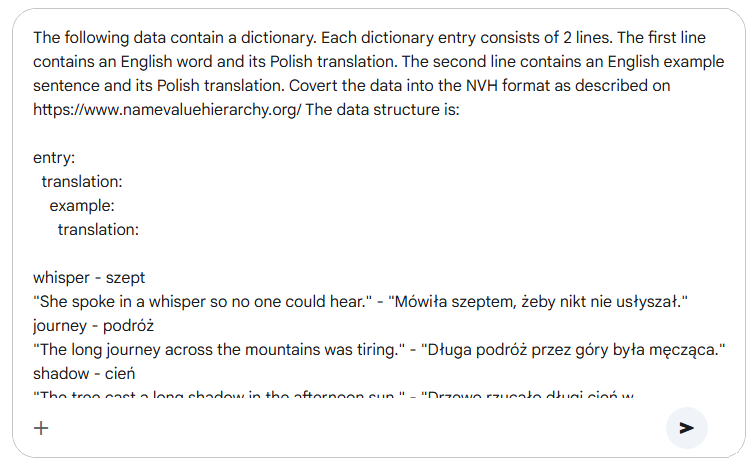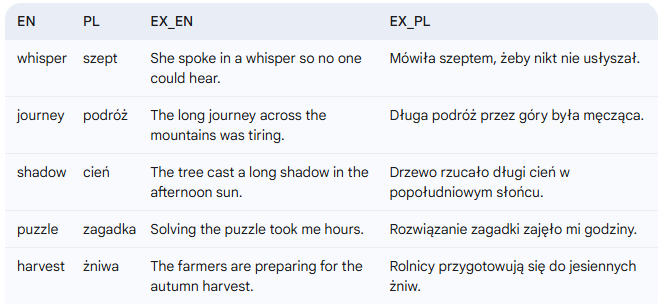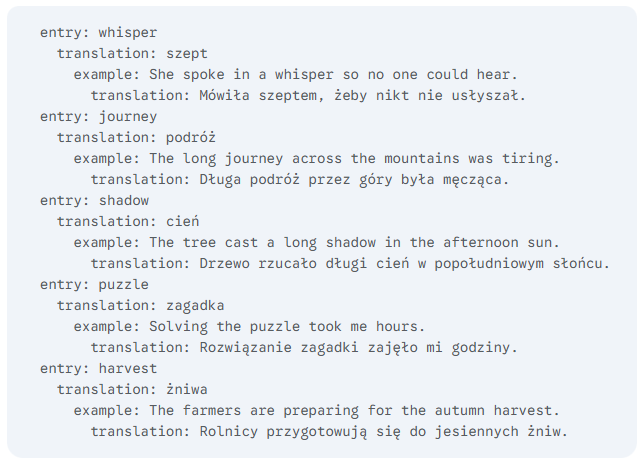Convert your dictionary programmatically
This option is especially suitable for very large dictionaries with complex entry structures.
Converting your dictionary to NVH requires some elementary programming skills. If you do not possess them, the easiest is to seek help. You do not need to look for top expert. This data conversion can be performed even by students who are into programming. Prepare the required entry structure first and provide the dictionary data to the programmer. They will write a simple script which will do the conversion.
Use AI to convert your dictionary
Using the AI is especially useful for small dictionaries with simple entry structure.
Depending on the AI tool, the data conversion function may be included in the free version or may require a subscription. The volume of data that can be processed may also be limited or you may have to split your dictionary into several batches. Check the condition of your AI tool.
Trial and error
Data conversion with AI is a process of trial and error. There is no best AI for dictionary conversion. There is no best, right or wrong prompt. The prompts can differ considerably depending on the input data and the expected result. Use the information below as an inspiration.
Example 1
If your dictionary data look like this example:
- each entry has two lines
- first line contains an English word and its Polish translation
- second line contains an English example sentence and its Polish translation
You can try a prompt like this:
The following data contain a dictionary. Each dictionary entry consists of 2 lines. The first line contains an English word and its Polish translation. The second line contains an English example sentence and its Polish translation. Covert the data into the NVH format as described on https://www.namevaluehierarchy.org/ The data structure is:
entry:
translation:
example:
translation:
Additional prompts
You may need to use additional prompts to fine-tune the result such as these (examples only for illustration, the additional prompts depend on the result the AI produces):
Remove the quotes around the example sentences.
Make each indent 2 spaces.
Make each indent a multiple of 2 spaces.
Indent the example translation by 2 more spaces.
The example sentences should be prefixed as “example:” and “translation:”
Indent example and example translation by two more spaces.
Dictionary data
whisper – szept
“She spoke in a whisper so no one could hear.” – “Mówiła szeptem, żeby nikt nie usłyszał.”
journey – podróż
The long journey across the mountains was tiring.” – “Długa podróż przez góry była męcząca.”
shadow – cień
The tree cast a long shadow in the afternoon sun.” – “Drzewo rzucało długi cień w popołudniowym słońcu.”
puzzle – zagadka
Solving the puzzle took me hours.” – “Rozwiązanie zagadki zajęło mi godziny.”
harvest – żniwa
The farmers are preparing for the autumn harvest.” – “Rolnicy przygotowują się do jesiennych żniw.”
Prompt
Example 2
If your dictionary data are in a table (Excel, Google Sheets, .html, .csv, or similar), you can try a prompt like this:
The following table contains a dictionary. The first row are column headings. EN is entry, PL is translation, EX_EN is example, EX_PL is example translation. Covert the data into the NVH format as described on https://www.namevaluehierarchy.org/ The structure is:
entry:
translation:
example:
translation:
Depending on the AI, the dictonary data should be submitted by:
- copying and pasting into the prompt
- including a link to the file with the dictionary
- uploading the dictionary as an attachment
If the result needs tweaking, use some additional prompts. You will find some inspiration at Example 1.






